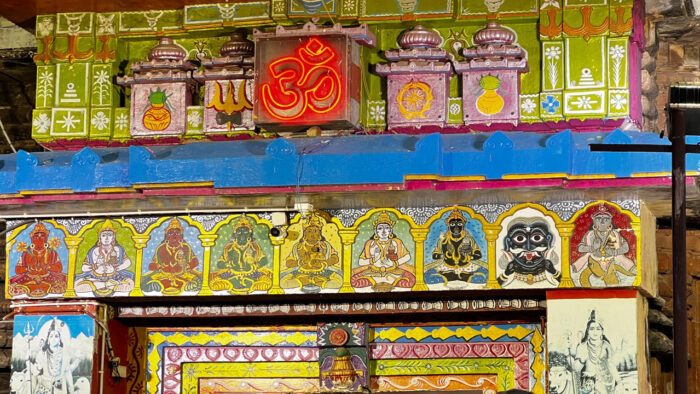A Temple, as per the Indian perspective, is more than a mere architectural marvel; it is a profound embodiment of philosophical thought, representing a journey of consciousness that transcends the boundaries of the mundane. Rooted in the philosophy of the UNIVERSE and the SELF, the temple structure serves as a metaphorical roadmap for the individual seeking higher states of awareness.
Let’s have a look at one single Mantra from the entire Upanishadic literature that encapsulates the ancient wisdom of interconnectedness of all. Here is the profound verse
“सर्वं ह्येतद् ब्रह्म अयमात्मा ब्रह्म ”
from Mandukya Upanishad (verse 2) which says this Self and what lies outside of it are all ONE. The seers and sages, through this insight, recognized the eternal interconnectedness of the Self with the entire Universe. They perceived all existence bathed in the light of the Self, acknowledging that the Universal Brahman and the individual Self are one.
In their profound understanding, the seers regarded everything external as an extension of their own Self. This awareness transcends the boundaries of individual identity, fostering a sense of unity with the cosmos. This profound realisation can be seen in the very structure of the temple where one finds oneself as if one is standing before a mirror and seeing oneself.
One normally sees that at the base of this sacred structure lies a symbolic representation of the animal kingdom — an allegory for the primal instincts and impulses that govern the lowest realms of human consciousness. Desire-काम (kāma), anger-क्रोध (krodha), greed-लोभ (lobha), delusion-मोह (moha), arrogance-मद (mada), and envy-मात्सर्य (mātsarya )find expression in the intricate carvings and depictions, reminding the visitor of the innate animalistic forces that drive the human psyche.
Moving beyond the animal consciousness, the temple ascends into the realm of the human. Here, the evolving consciousness of humanity unfolds, urging individuals to transcend their baser instincts and embrace a heroic consciousness, free from weaknesses and shortcomings. The depiction of the human world and its affairs serves as a testament to the potential for growth and evolution inherent in every individual.
Above the human world, the temple introduces the visitor to the kingdom of gods and other non-material forces. This transcendent space symbolises the aspirational journey towards divine consciousness, inviting individuals to rise above earthly concerns and connect with the sacred. As one continues to ascend through the various planes of consciousness, the temple structure mirrors the shape of a flame — a poignant symbol of the aspirational fire that must burn within every seeker. This flame represents the fervent desire for spiritual evolution and self-realization, propelling individuals towards the infinitude of divine consciousness.
Central to this spiritual journey is the garbhagriha, where the prānapratishtita devatā — the deity with its living presence — is enshrined. This inner sanctum symbolizes the cave of the heart (hridguhā), inviting individuals to deeply contemplate the divine secret within themselves. The act of prayer, surrender, and wholehearted devotion becomes a means to invoke the living presence of the divine, guiding one’s entire life towards a higher purpose.
Crucially, this profound journey within does not entail escapism from the world. The temple philosophy emphasizes active participation in worldly activities while maintaining a deep connection with the divine. From the world of animals to the human realm and beyond, the temple encapsulates the entirety of existence, urging individuals to find divinity in the midst of their daily lives.
This vision aligns with the tenets of Tantra, providing a transformative roadmap for refining consciousness. The individual progresses from man-animal (pashu) to man-human (veera) and ultimately to man-divine (divya). The temple, in its entirety, stands as a symbol of this evolutionary vision, inviting each seeker to set foot on the ultimate goal of life — a journey towards divine consciousness.
Note on the Essence of “Mandira” or “ Devālaya”
The profound significance of the word “Mandira” or temple extends beyond its linguistic roots, shedding light on a deeper meaning inherent in its etymology. Derived from the root-sound “mand,” the term encompasses a spectrum of emotions — rejoicing, being delighted, inflaming, inspiriting, and shining. This linguistic richness reveals that a mandira is more than a physical structure; it is a sacred space designed to evoke profound emotions and connect individuals with a state of bliss.
Inherent in the word “Mandira” is the notion of rejoicing and being delighted, suggesting that the temple is a place where individuals experience profound joy and delight. The act of inflaming and inspiriting within the temple environment signifies a transformative process, igniting the spiritual flame within individuals and inspiring them towards higher states of consciousness. The shining aspect implies a luminosity that emanates from the temple, symbolizing the illumination of one’s inner self.
Crucially, the word “Mandira” leads us to the idea that this sacred space serves as a conduit to Ananda — the ultimate attainment. Ananda, representing divine bliss, becomes the focal point of the temple experience. It underscores that the purpose of the temple is not merely ritualistic but a journey towards a state of profound joy and spiritual fulfillment.
Moreover, the term “temple” finds resonance in the alternate appellation of “devālaya.” Literally translating to the “house” or “abode of devas,” it imparts a deeper meaning to the sacred space. Devas, as the children of Light, Delight, Unity, and Harmony, embody the divine qualities that permeate the temple environment. As a devālaya, the temple becomes a dwelling place for these celestial beings, fostering an atmosphere of light, joy, unity, and harmony. The temple, in its architectural and spiritual grandeur, serves as a conduit for individuals to connect with these divine attributes, thereby enriching their spiritual journey.
In essence, a temple encapsulates a profound philosophy — a philosophy of rejoicing, delight, inspiration, and connection with Ananda. It beckons individuals to partake in a sacred dance of consciousness, ultimately leading to the blissful attainment of divine joy and harmony. In its entirety, it symbolises not only a physical structure but a gateway to a higher realm — a realm where the journey of consciousness culminates in the blissful embrace of Ananda.
आनन्दान्न परो लाभः
ānandānna paro lābhaḥ
There is no greater gain than Ananda.
Disclaimer: The opinions expressed in this article belong to the author. Indic Today is neither responsible nor liable for the accuracy, completeness, suitability, or validity of any information in the article.








